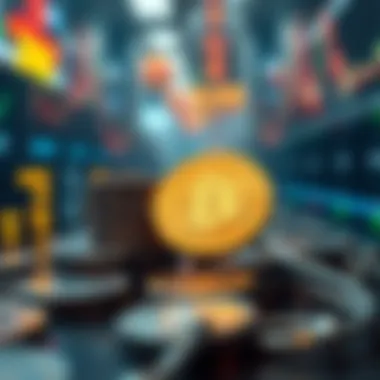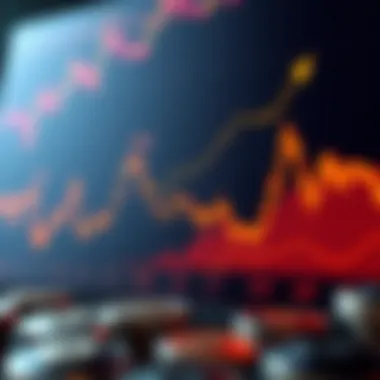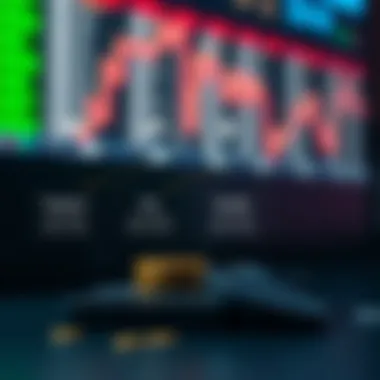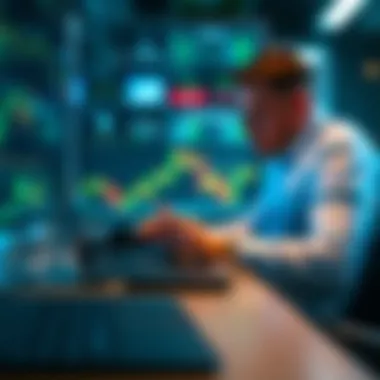Understanding Margin on Futures in Cryptocurrency Trading


Intro
In the rapidly evolving world of cryptocurrency, the concept of margin trading has become a focal point for many investors. This is especially true in futures markets, where the possibility for substantial returns coexists with significant risks. Entering this arena demands a clear understanding of what margin entails, particularly how it operates in the unique environment of digital currencies.
This article is designed to unfold the layers of complexity surrounding margins in futures trading. By delving into the core elements—ranging from fundamental principles of margin trading to the implications of volatility on margin levels—we aim to equip traders with the knowledge necessary to navigate these turbulent waters.
Whether you're a seasoned investor or someone just dipping your toes into the crypto sea, grasping the nuances of margin can serve as a cornerstone for smarter trading decisions.
Prelims to Margin on Futures
Navigating the complex world of futures trading entails a firm grasp of the concept of margin. This section paves the way for understanding how margin impacts trading strategies and risk management, especially in the dynamic cryptocurrency markets. Margin, in essence, acts as a safety net for both traders and exchanges, ensuring that there are funds available to cover potential losses on trades. Understanding this concept is crucial for any investor looking to make calculated decisions rather than jumping in and hoping for the best.
Defining Margin in the Context of Futures Trading
At its core, margin is not what gets lost at the bar on a Friday night; it’s a deposit that traders must put down when they take on a position in the futures markets. Specifically, when you're trading futures contracts, the margin serves as both a good faith deposit and a risk management tool. If a trader wants to purchase a futures contract with a notional value of, say, $10,000, they may only need to deposit a fraction of that amount—often around 5% to 10%—as their initial margin. This allows traders to control a larger position while tying up less capital, creating opportunities for amplified gains.


However, it’s vital to note that margin is not free money. If the market turns against them, traders must be prepared to meet additional capital requirements known as maintenance margin. Should their account balance fall below this threshold, they’ll receive a margin call, urging them to add more funds to avoid a liquidation of their position.
The Role of Margin in Leverage
Leverage is the double-edged sword of trading; it can create exceptional profit potential but can also usher in substantial losses. Margin plays a central role in this dynamic, allowing traders to leverage their trading power. When a trader puts up margin, they’re essentially borrowing funds from the broker to amplify their position size. For example, if a trader deposits $1,000 in margin, they could theoretically control a $20,000 position with the right leverage ratio.
This leverage can supercharge profits when the market moves in the right direction. A mere fraction of a point increase can mean the difference between a modest gain and a significant payout. Conversely, a small adverse movement in the market can lead to swift losses, making it essential for traders to understand both the potential rewards and inherent risks associated with margin trading.
Margin trading, while alluring, requires a careful assessment of one's risk appetite and the realities of market behavior. Investors must approach it with a clear strategy in mind, ready to adapt to the unpredictable nature of cryptocurrency prices.
Types of Margin in Futures Trading
Understanding the types of margin in futures trading is crucial, especially when dabbling in the volatile waters of cryptocurrency markets. Margin acts not just as a fundamental component of any leverage strategy, but also dictates how traders can interact with the market, their risk exposure, and the potential returns on investment. Amidst the rapid price swings in crypto assets, grasping the two primary types of margins—initial and maintenance—is vital for anyone looking to establish a foothold in this space.
Initial Margin: A Prologue to Investment
The initial margin is essentially the upfront capital that a trader must deposit to open a futures position. Picture this as the cost of entry into a game—without it, you can't play. This amount varies depending on the asset class and volatility. For crypto futures, exchanges like Binance or BitMEX set these thresholds to mitigate risk, ensuring that only serious traders participate. It's the proverbial gatekeeper that determines who gets to journey into the world of futures trading.


When calculating initial margin, exchanges typically consider factors like the current market price and historical volatility, among others. For example, if a trader wants to buy a futures contract for Bitcoin priced at $40,000, and the exchange mandates a margin of 10%, the trader would need to post $4,000 as initial margin.
This arrangement allows traders to gain exposure to larger positions, using less of their own capital while relying on borrowed funds. However, it’s a double-edged sword; while it enhances potential profits, it equally heightens risk. Hence, a trader needs to tread carefully, analyzing not only their financial position but also market conditions before committing.
“Understanding your initial margin requirements can be the difference between a profitable trade and a financial catastrophe.”
Maintenance Margin: Ensuring Continued Participation
Once the initial margin is posted and the trade is active, the maintenance margin takes center stage. This is the minimum amount of equity a trader must maintain in their margin account to keep a position open. If the market moves against a trader's position and the account equity dips below this threshold, a margin call will occur. In simple terms, a margin call is a broker's way of saying, “Hey, you need to add more funds to your account, or we will close your position.”
In the crypto world, where volatility can swing dramatically, understanding maintenance margin is critical. Let's say a trader's initial margin was $4,000, but the maintenance margin is set at 5% of the position value. If the Bitcoin price drops sharply, leading to losses that drop the account balance below that threshold, action must be taken fast—failing which positions may be liquidated to cover the deficit.
Key Considerations for Maintenance Margin:
- It regularly fluctuates based on market conditions and the asset in question.
- Traders should monitor their equity closely, particularly in volatile markets, to avoid unintended liquidations.
- Having additional funds ready can help manage potential margin calls and keep positions secure.


In essence, initial and maintenance margins serve as essential tools for traders navigating the ups and downs of the futures landscape. Being well-versed in these concepts can set apart the successful from those who find themselves unprepared in an unforgiving marketplace.
The Margin Process in Cryptocurrency Futures
The margin process in cryptocurrency futures is a multifaceted subject that bears significant weight in the trading ecosystem. As investors dip their toes into the world of crypto futures, grasping how margin works becomes essential. Margin is essentially collateral that traders put up to secure a position, which allows them to leverage their investments. By doing so, they can control larger sums of money than they currently own, effectively amplifying both potential gains and losses.
There are several critical elements to consider regarding this complex process:
- Initial Steps: Understanding how much capital is required upfront to enter a position is crucial; this is termed the initial margin.
- Ongoing Management: The necessity for maintaining a certain balance in your account, known as maintenance margin, must not be overlooked.
- Real-time Adjustments: The volatile nature of the cryptocurrency market means that the margin requirements can fluctuate significantly, affecting traders’ positions unexpectedly.
How Margin is Computed in Crypto Futures
When traders engage in crypto futures, calculating the margin is not as straightforward as it may seem. The margin is typically derived from a set of parameters that deal with the price of the asset, the amount of leverage, and the performance of the position.
For instance, if a trader wishes to control a contract worth $10,000 and the exchange offers a leverage of 10x, they would only need to put down $1,000 as their margin. However, if the value of the asset drops, the margin requirement could quickly shift:
- Leverage Ratios: Understanding how different leverage ratios affect not just initial requirements but ongoing obligations is key for strategic positioning.
- Market Volatility: Fluctuations in asset price can lead to sudden requests for more collateral; hence, tracking these changes is essential. Failure to maintain sufficient margin can trigger a margin call.
Example Calculation: If your position is worth $5,000 and the margin requirement is 5%, you'd need to have $250 in your account. The formula generally follows this structure:
plaintext Margin Amount = (Position Value) x (Margin Percentage)



